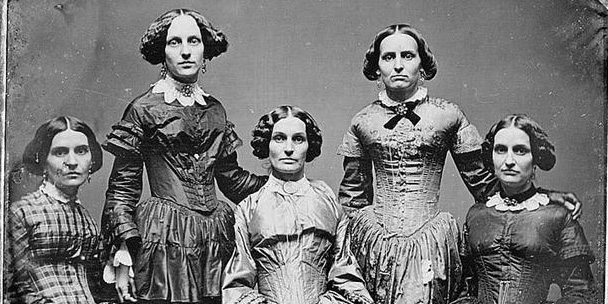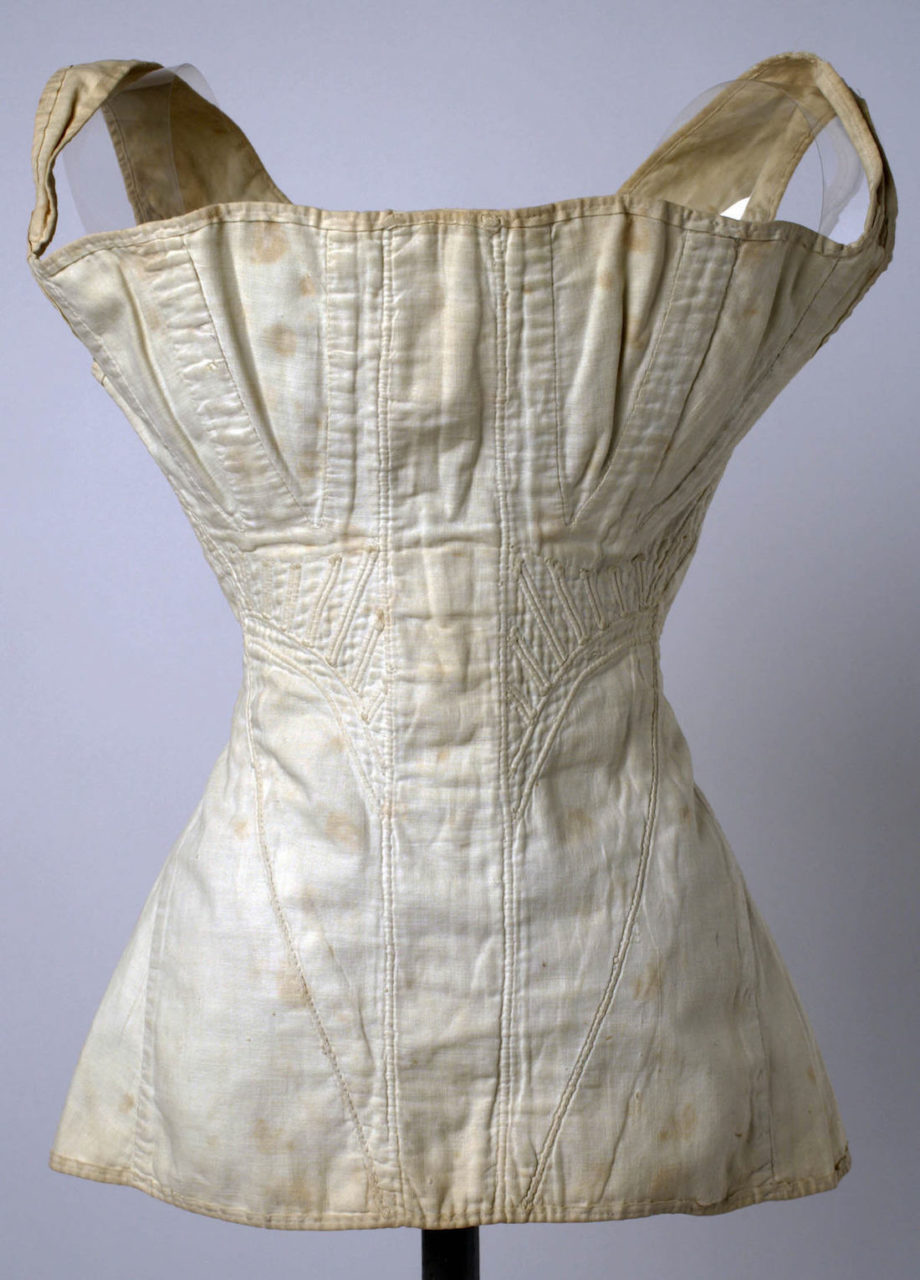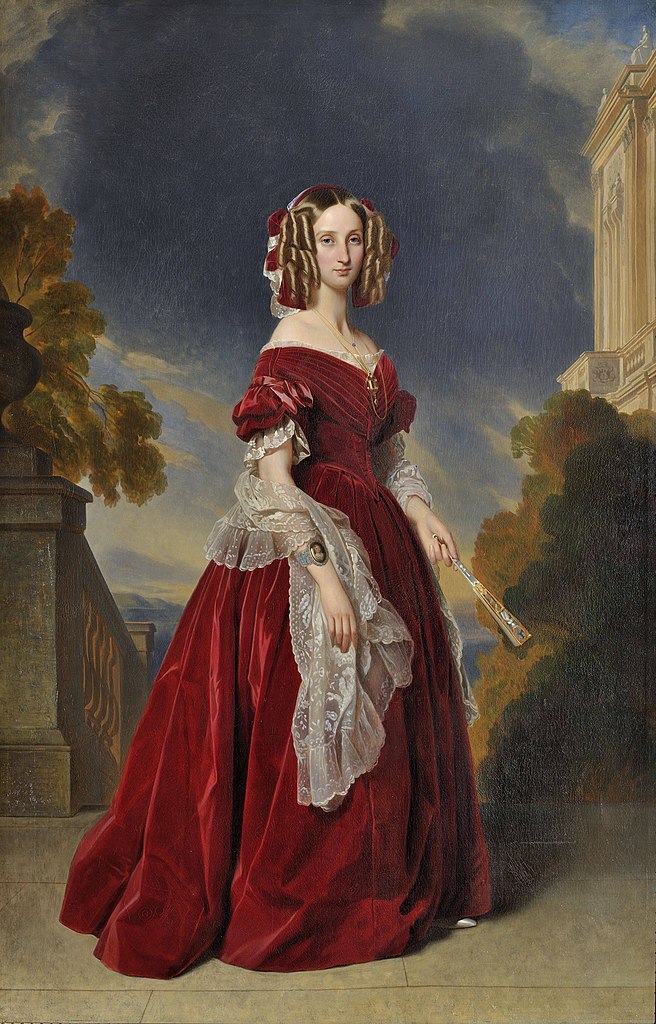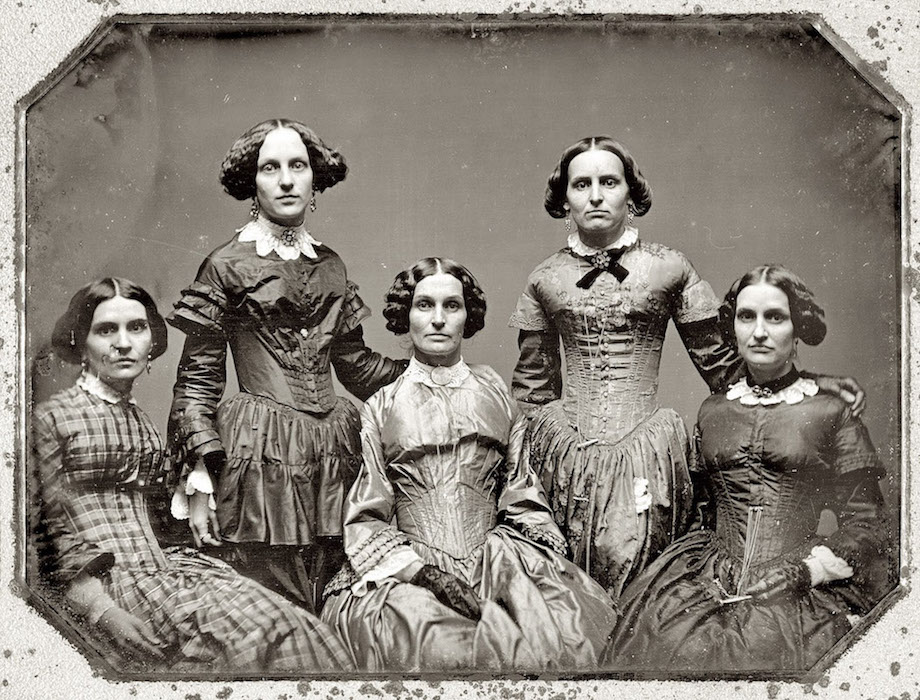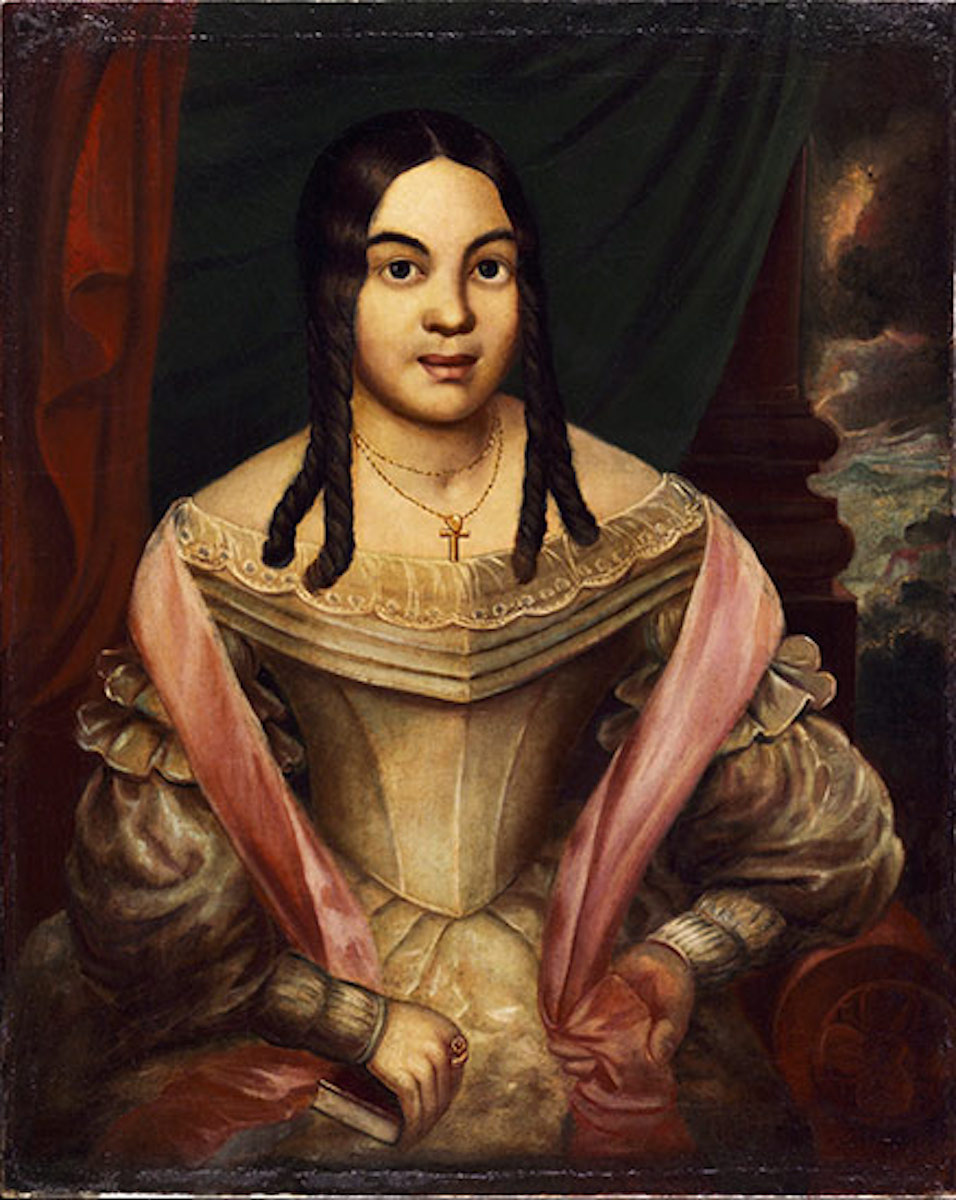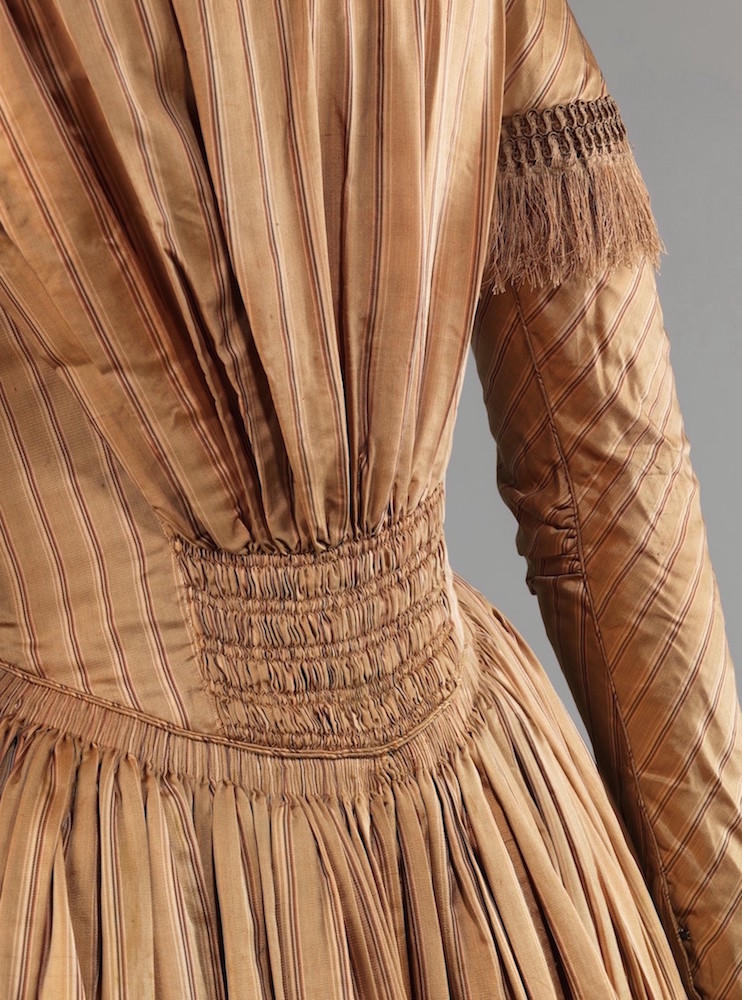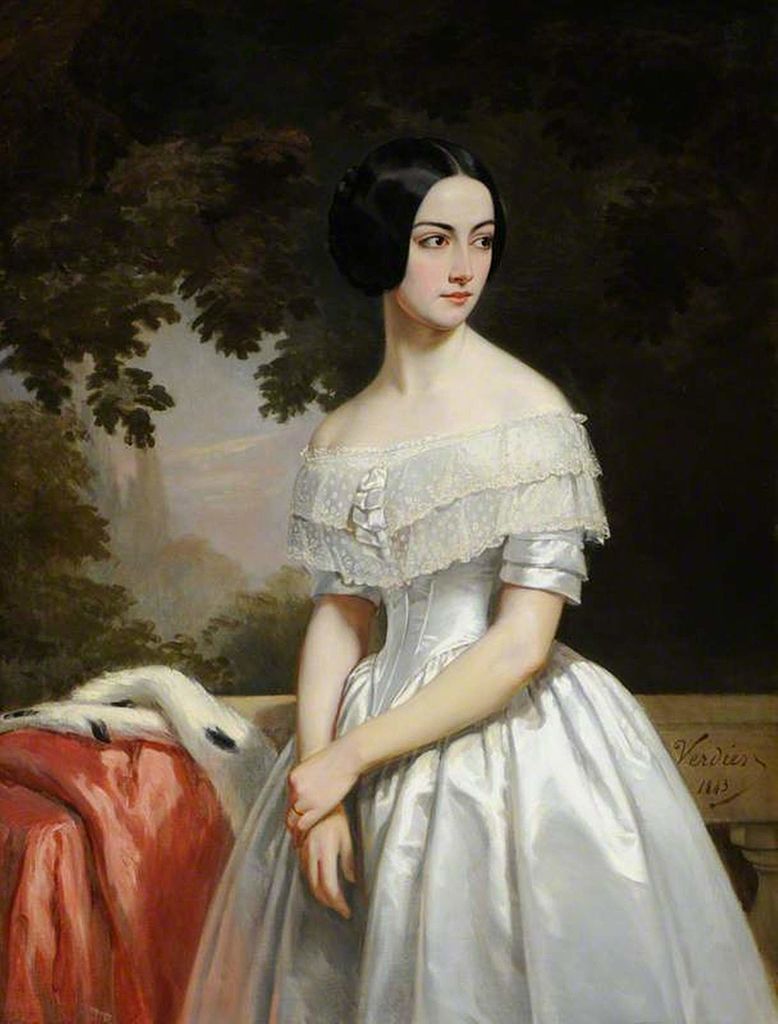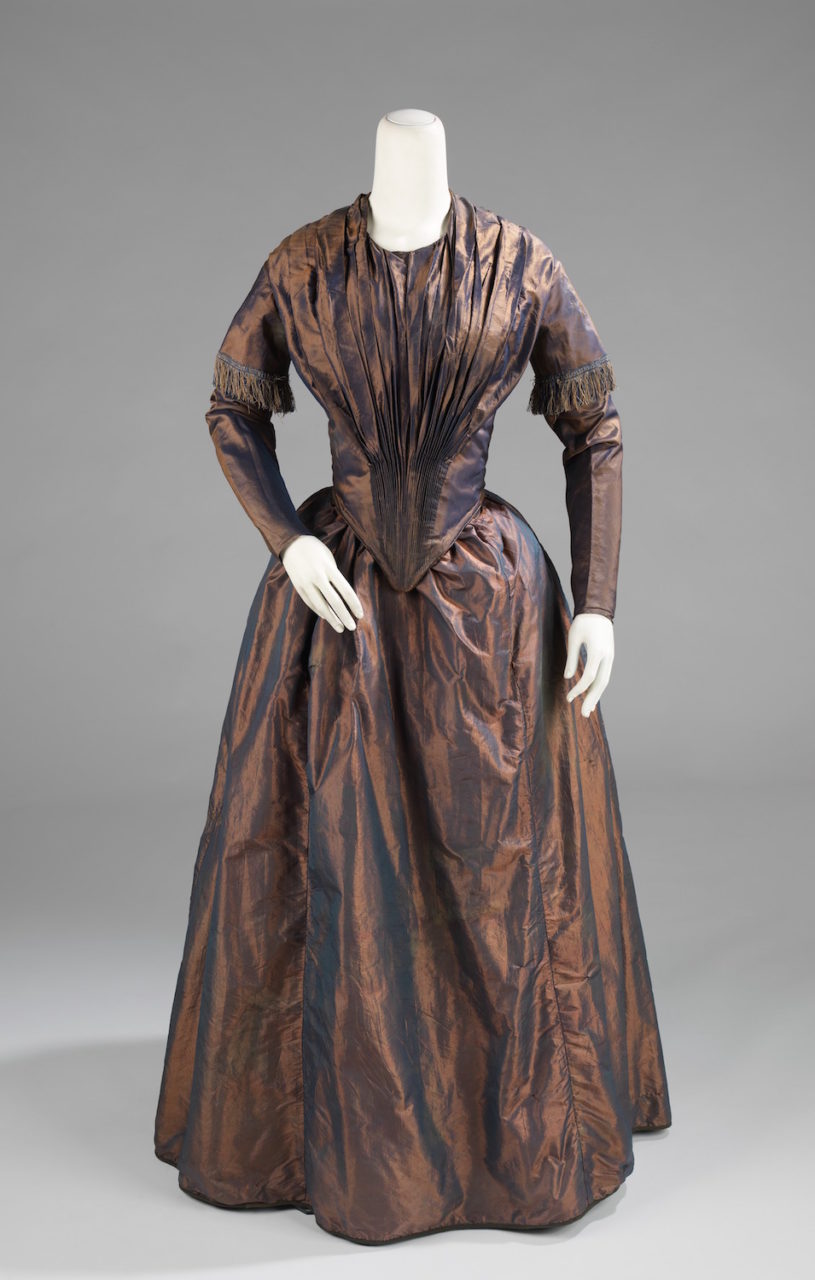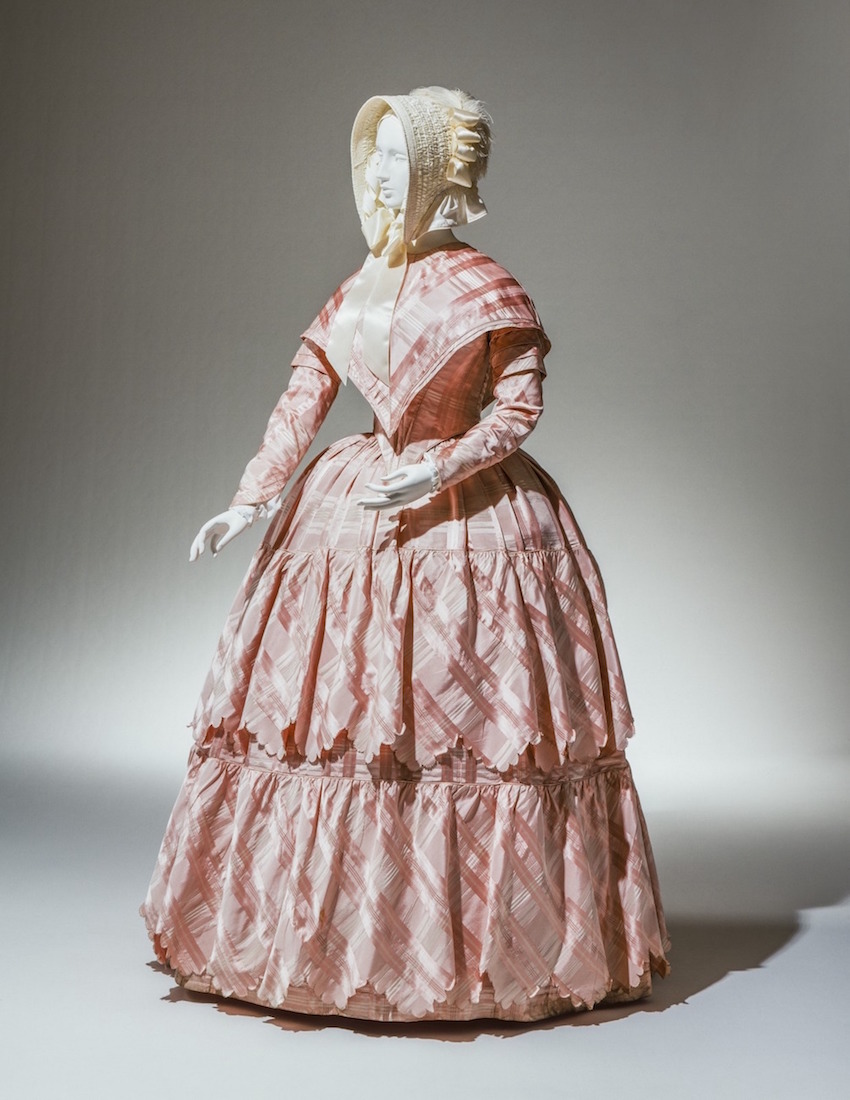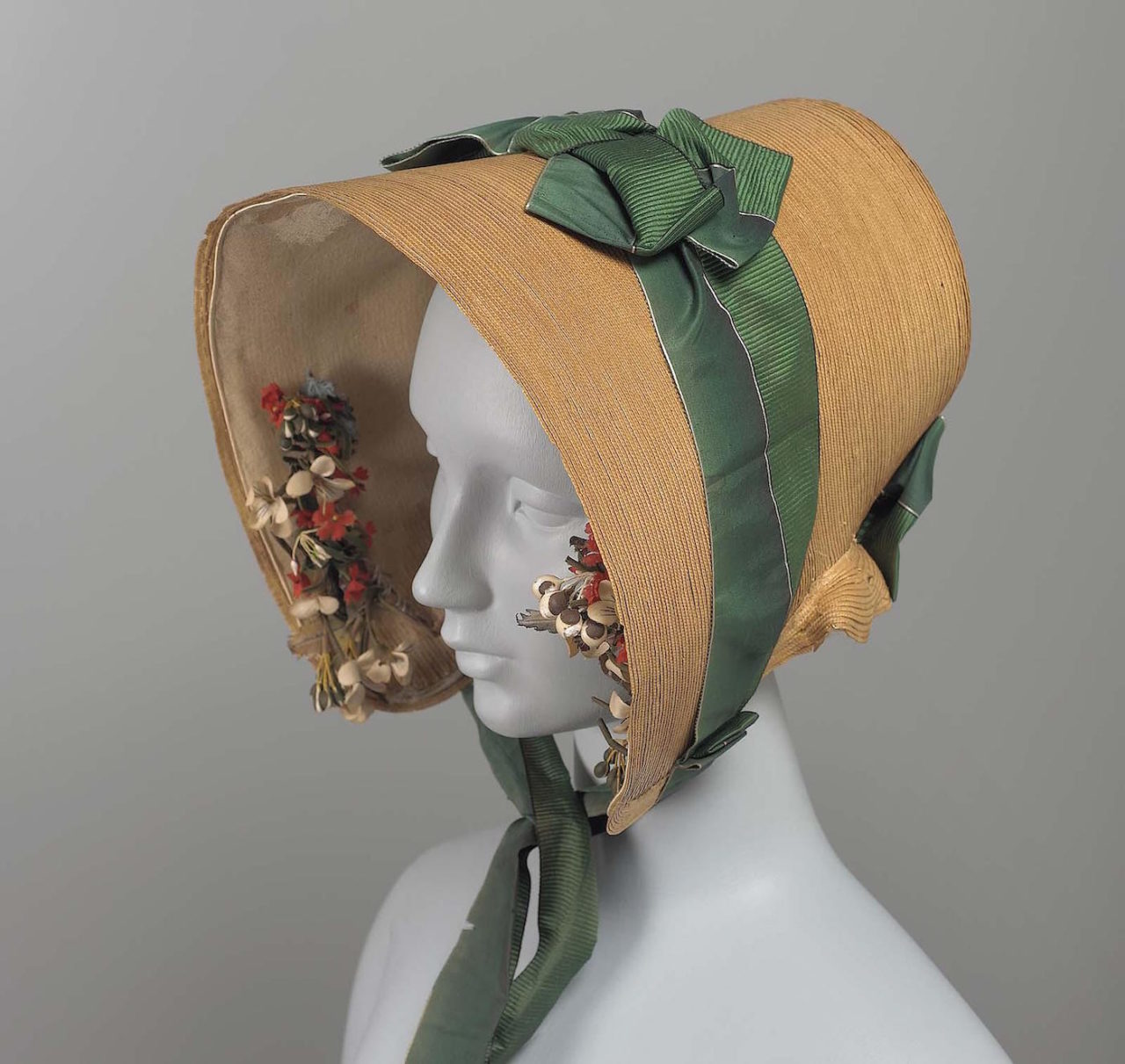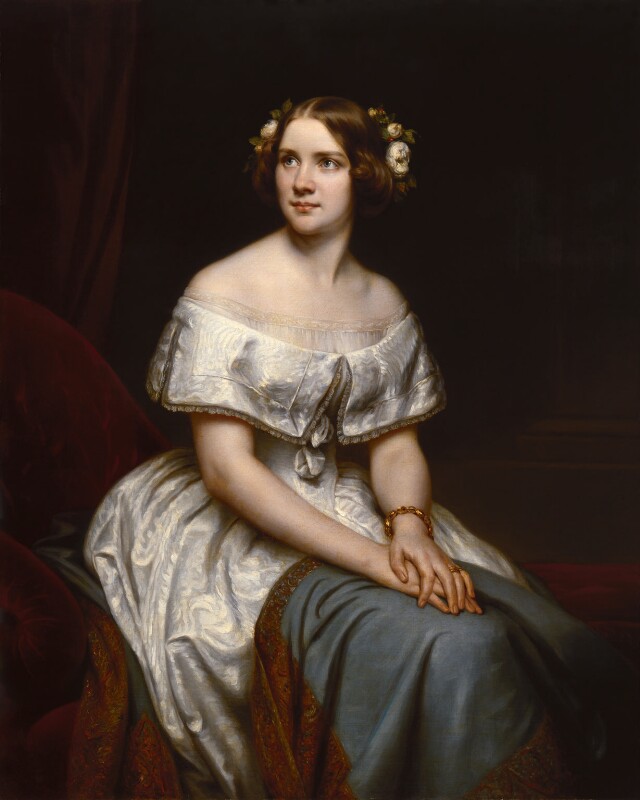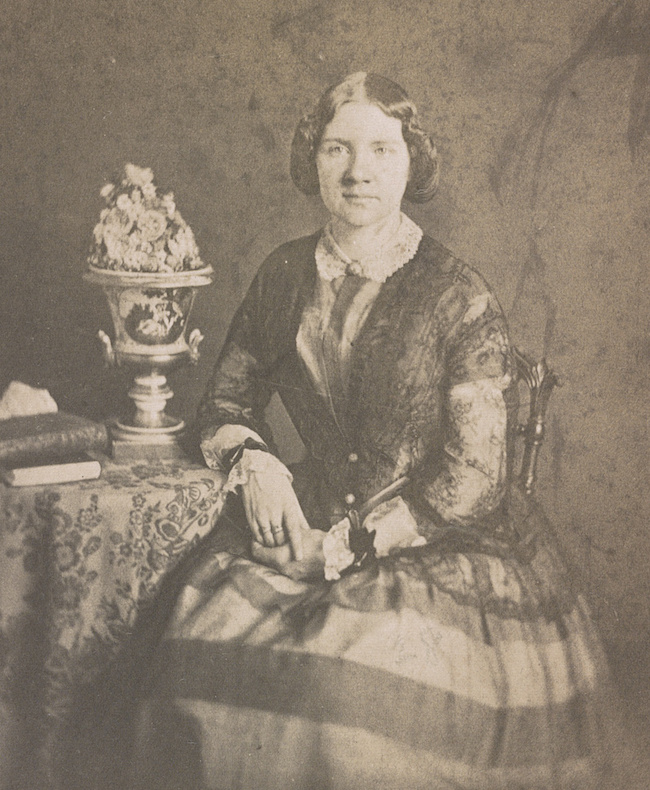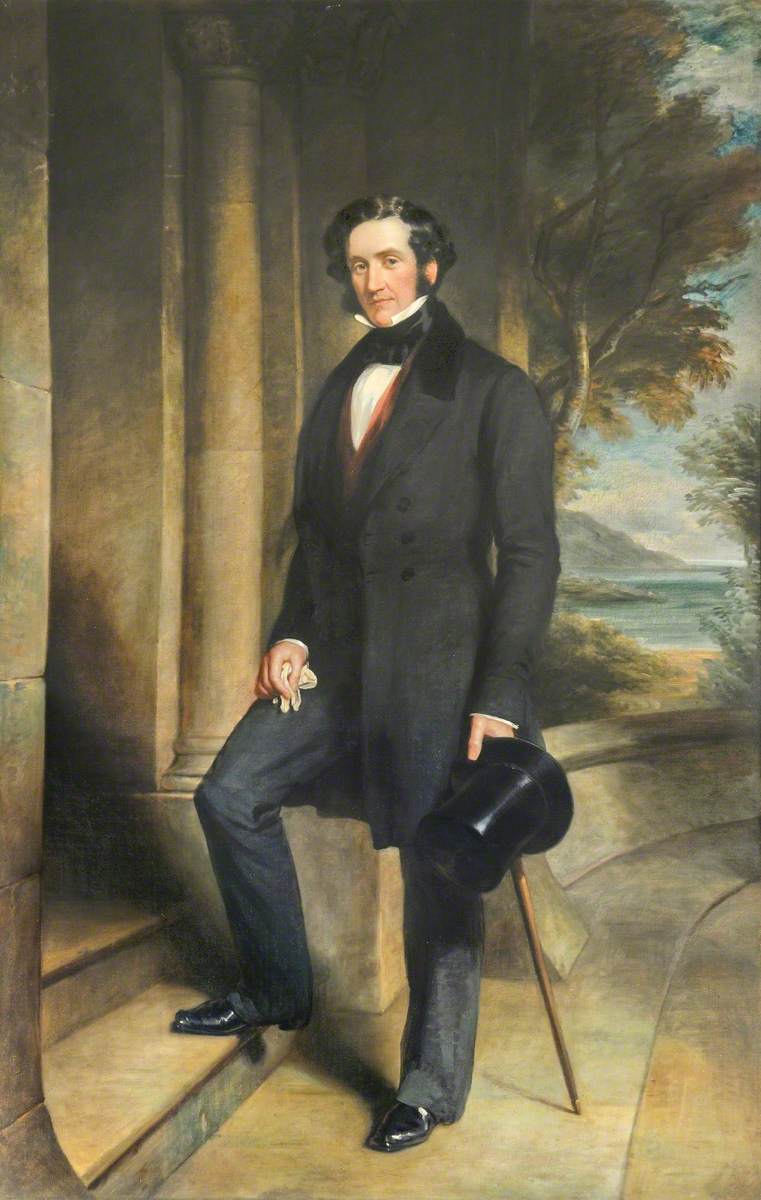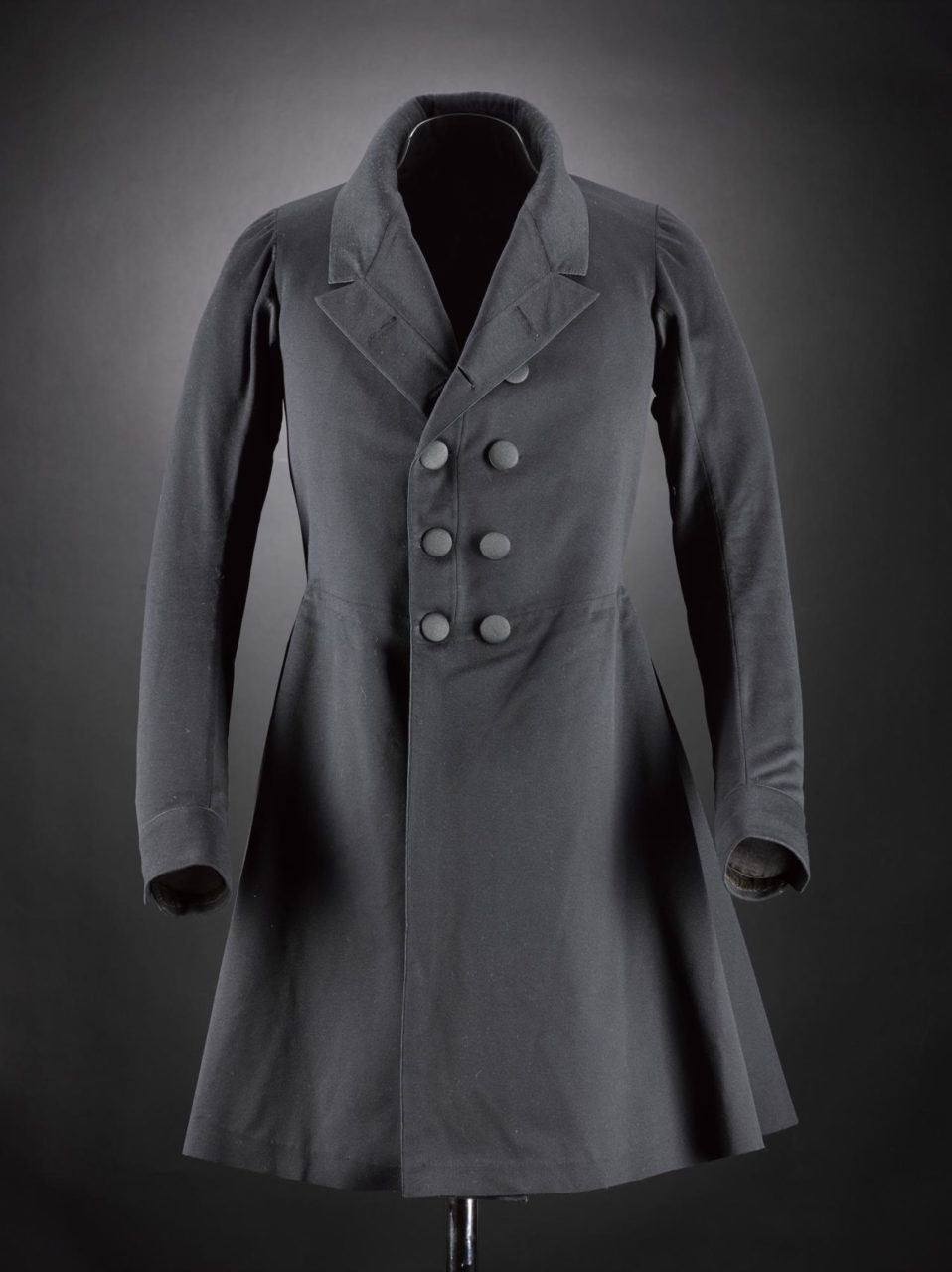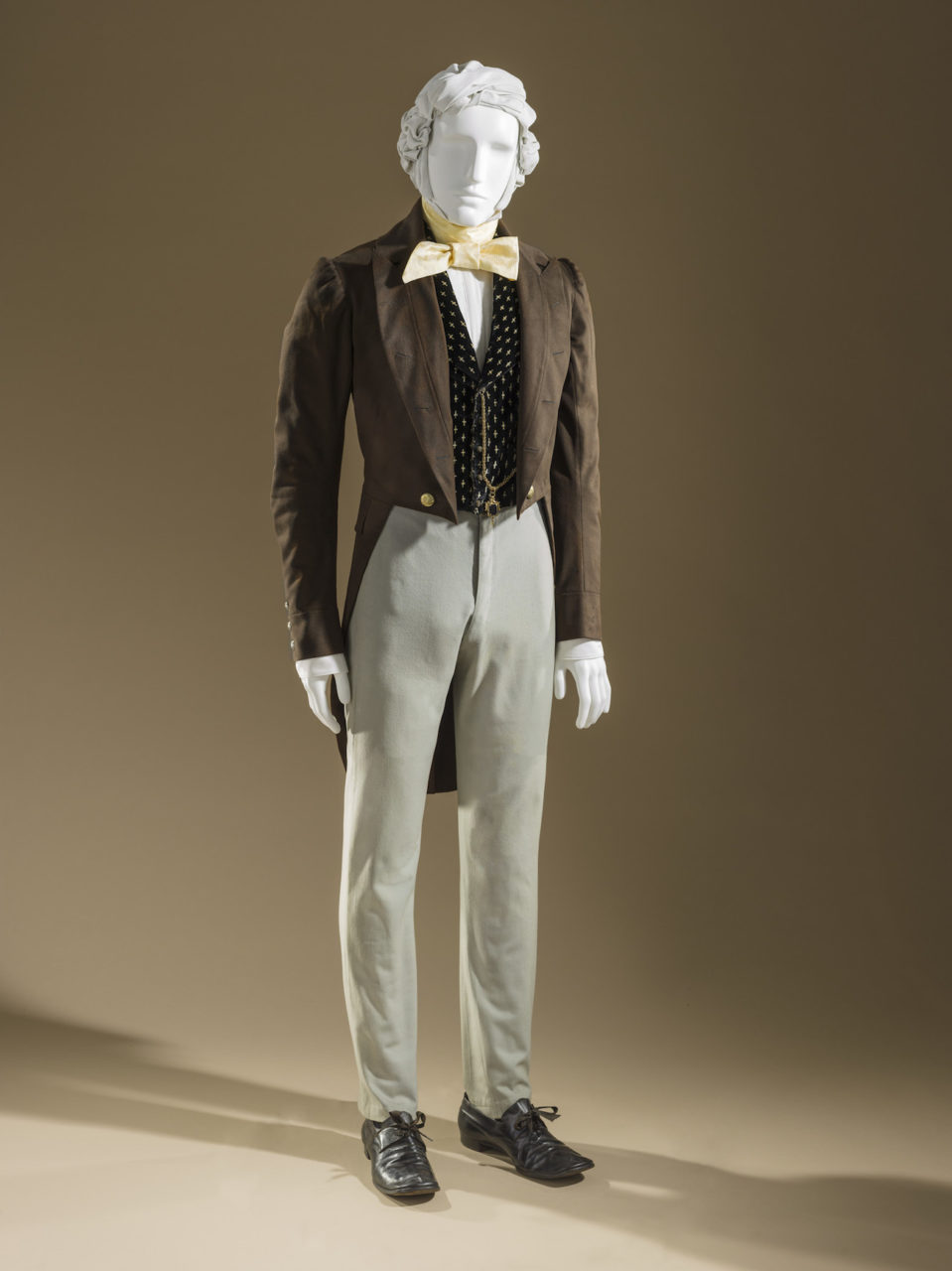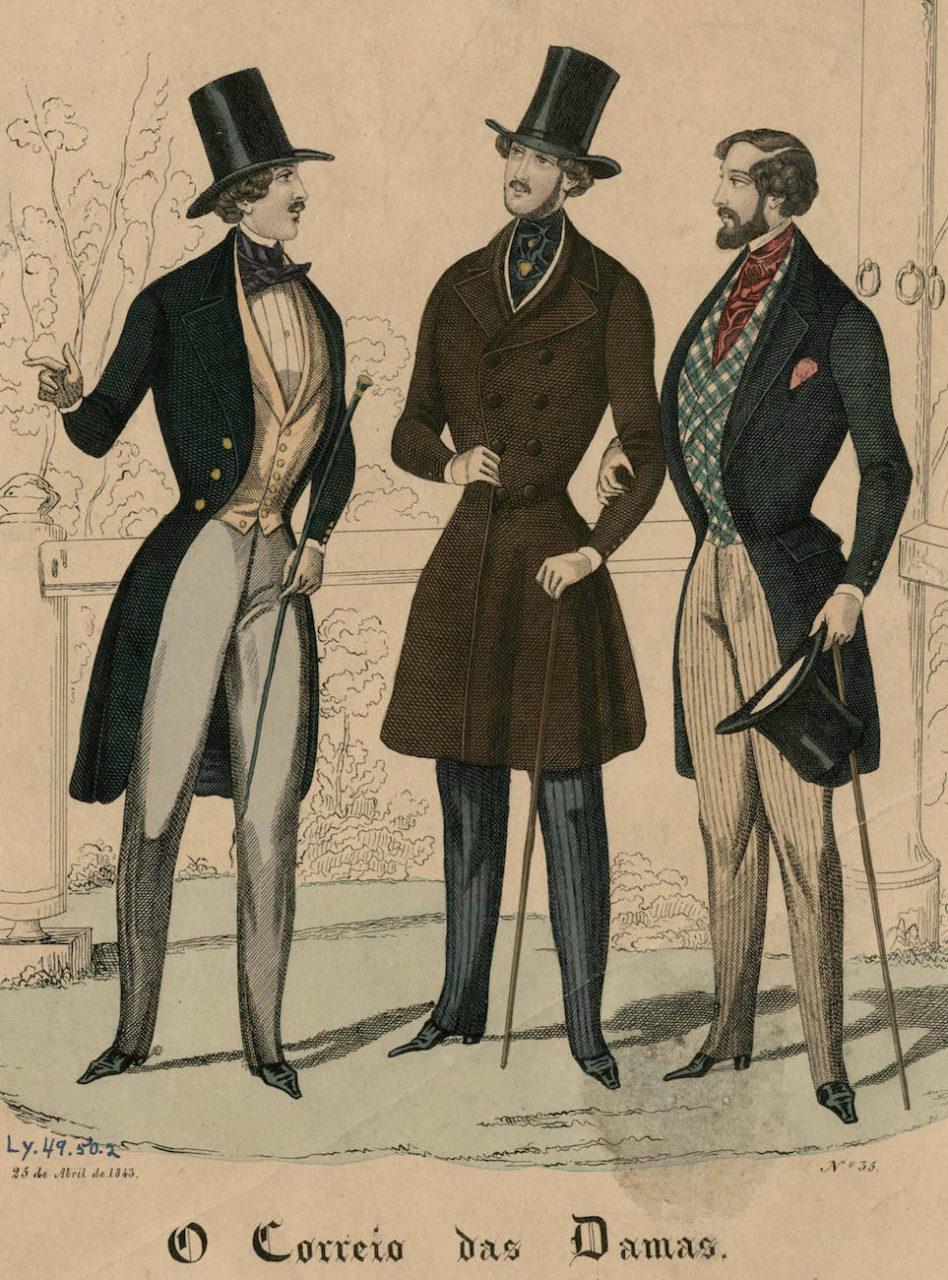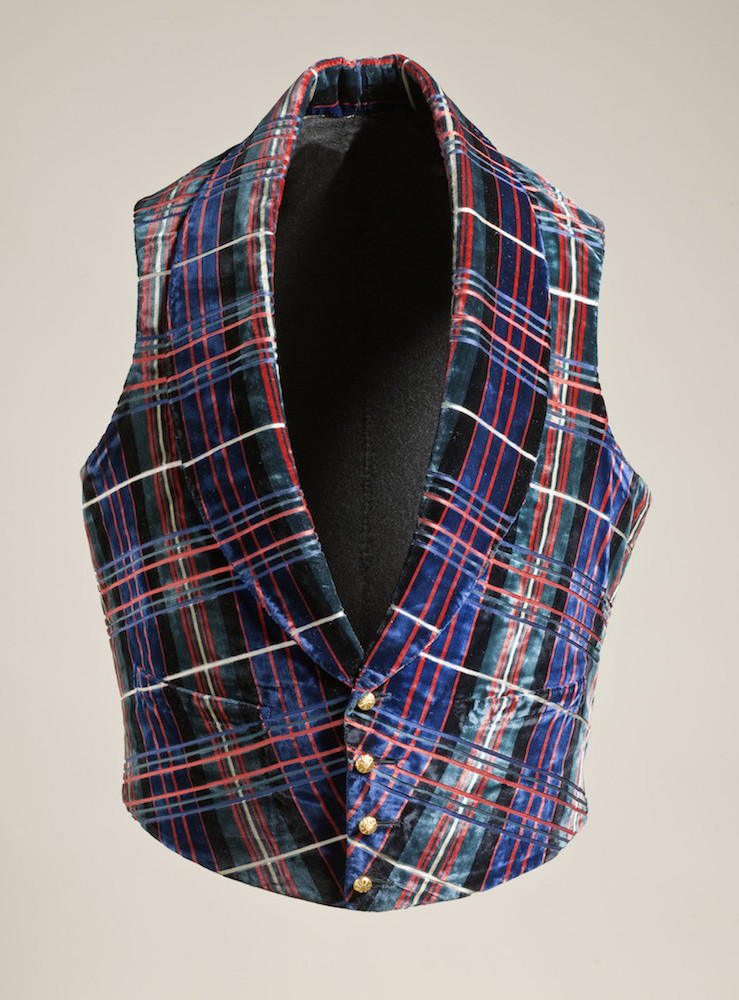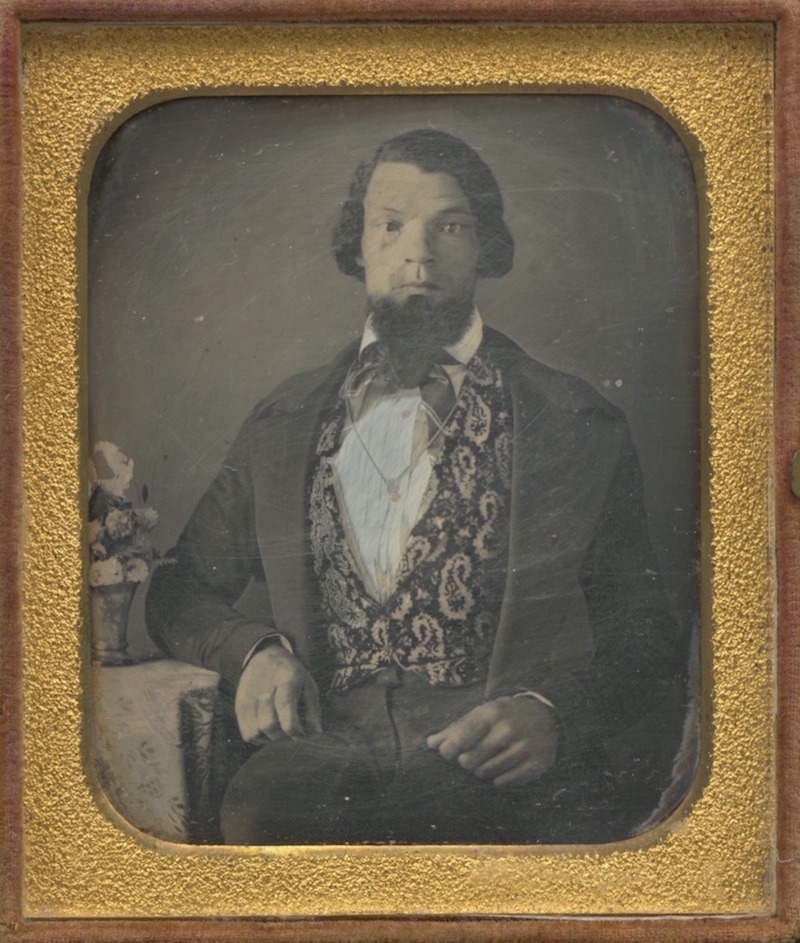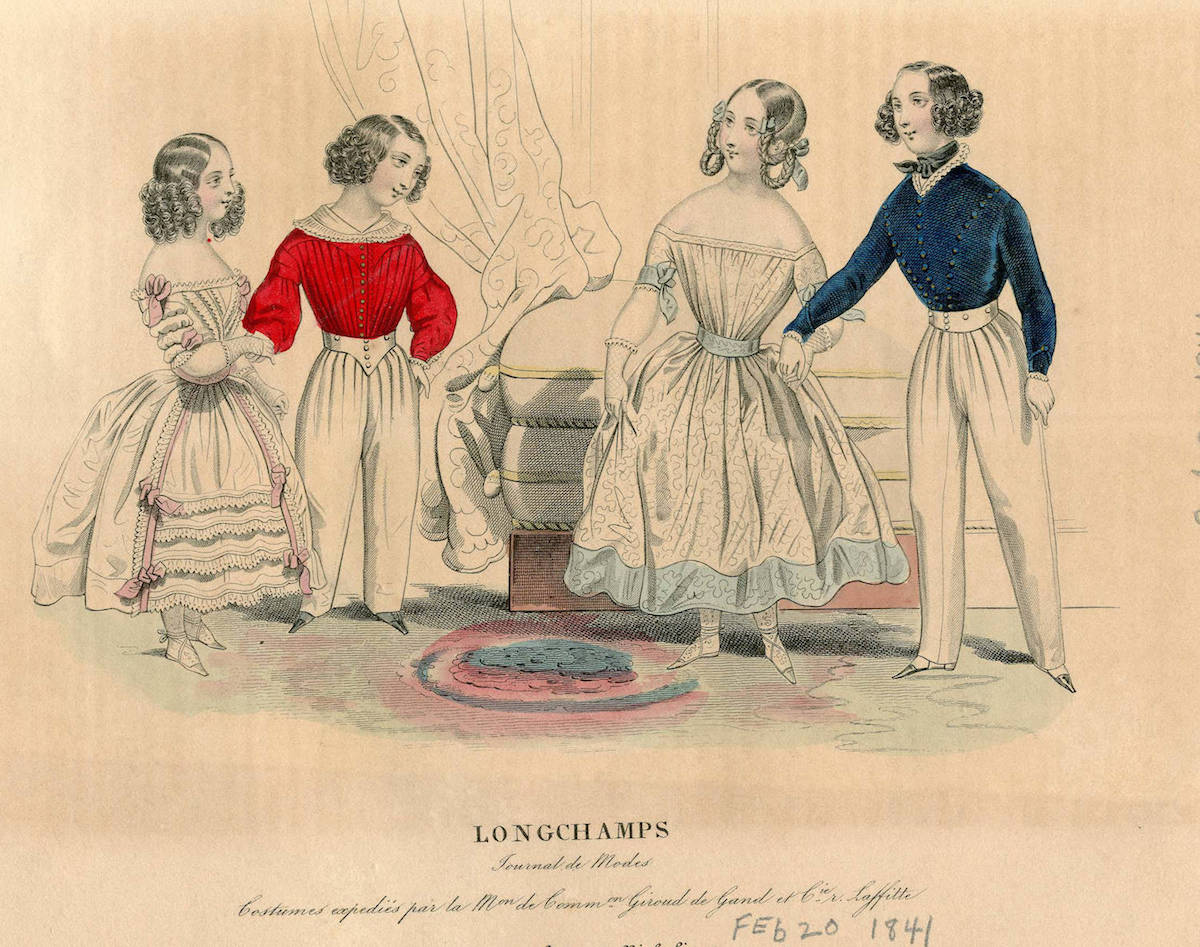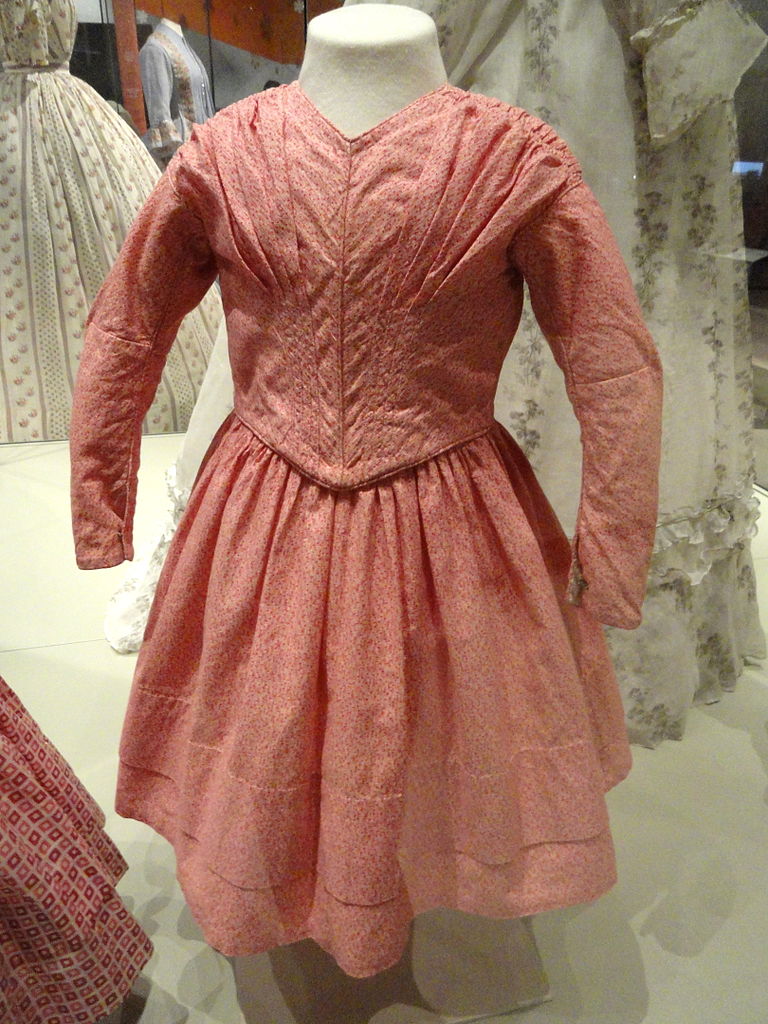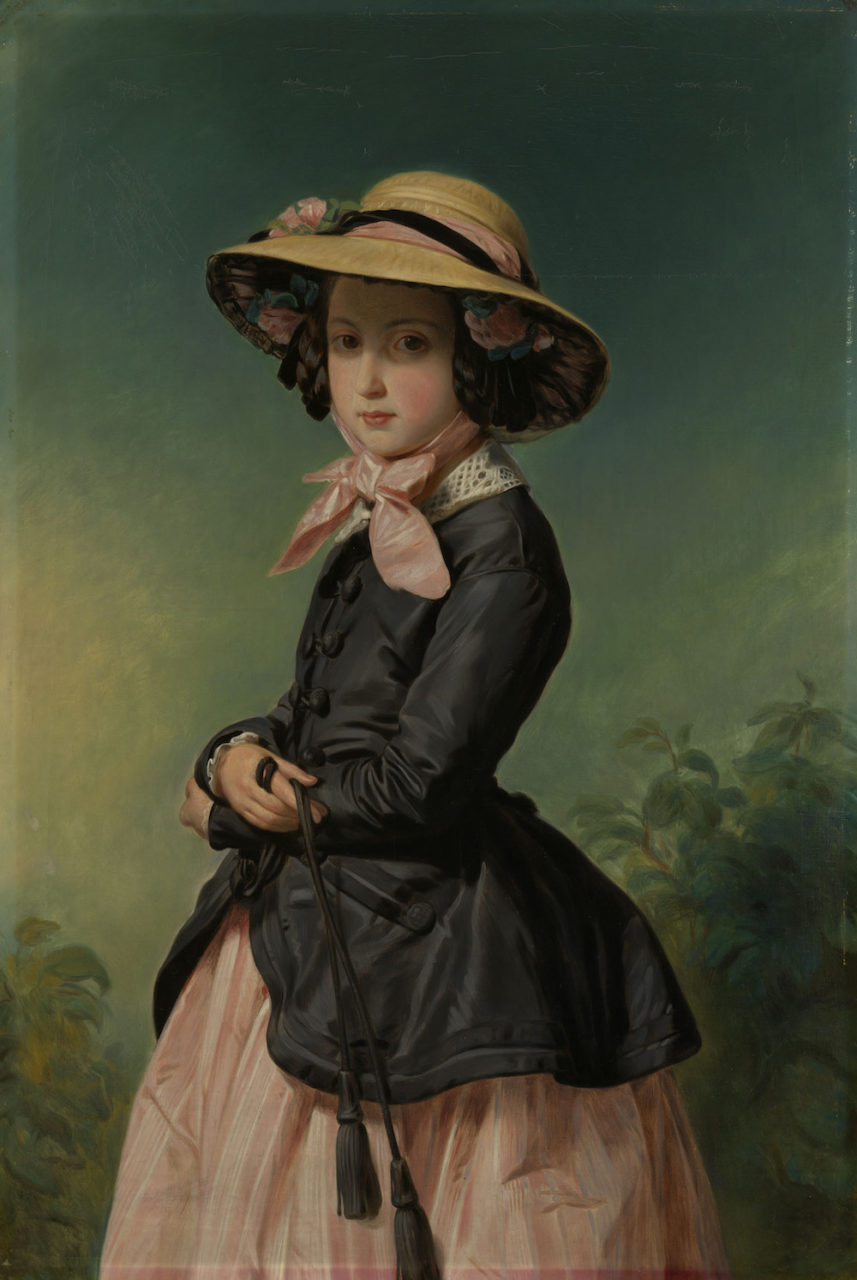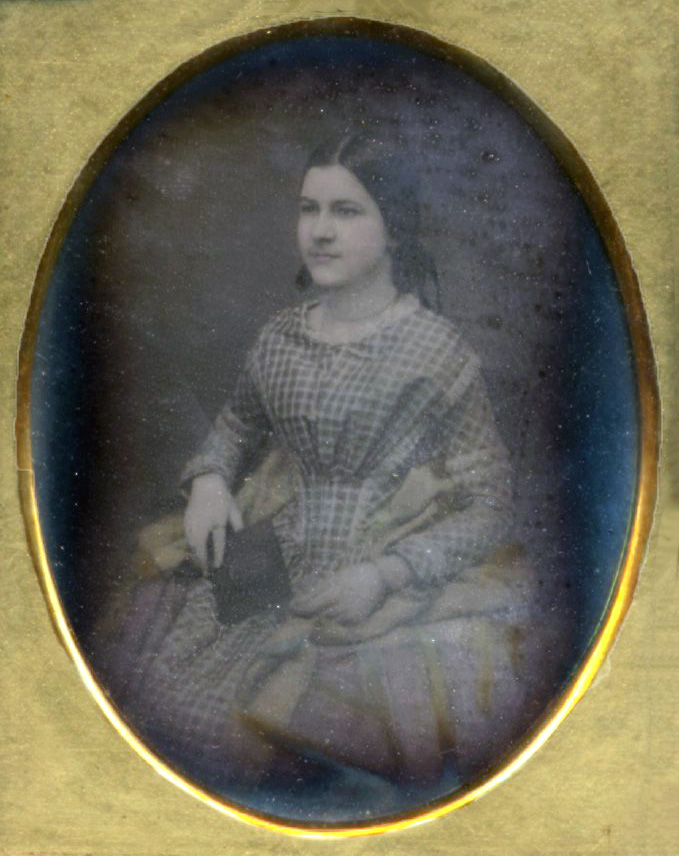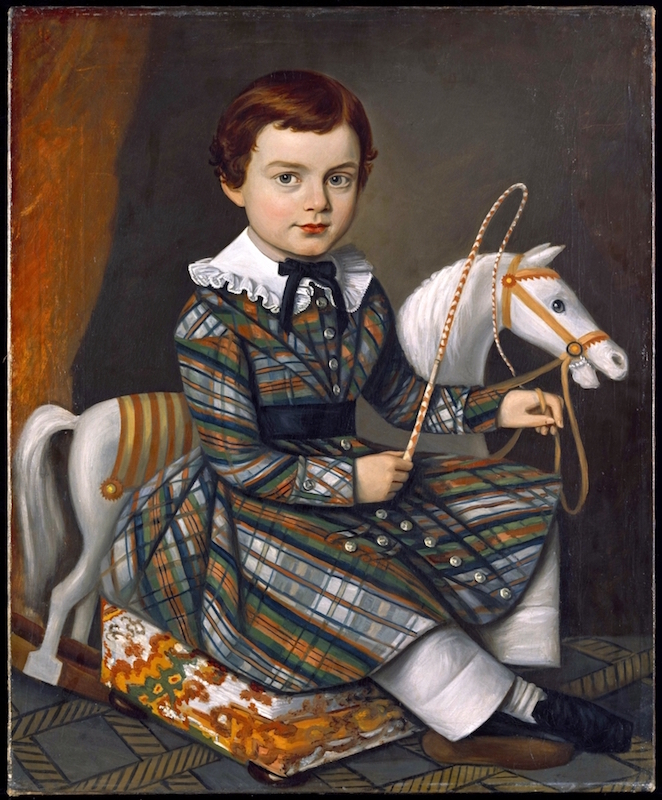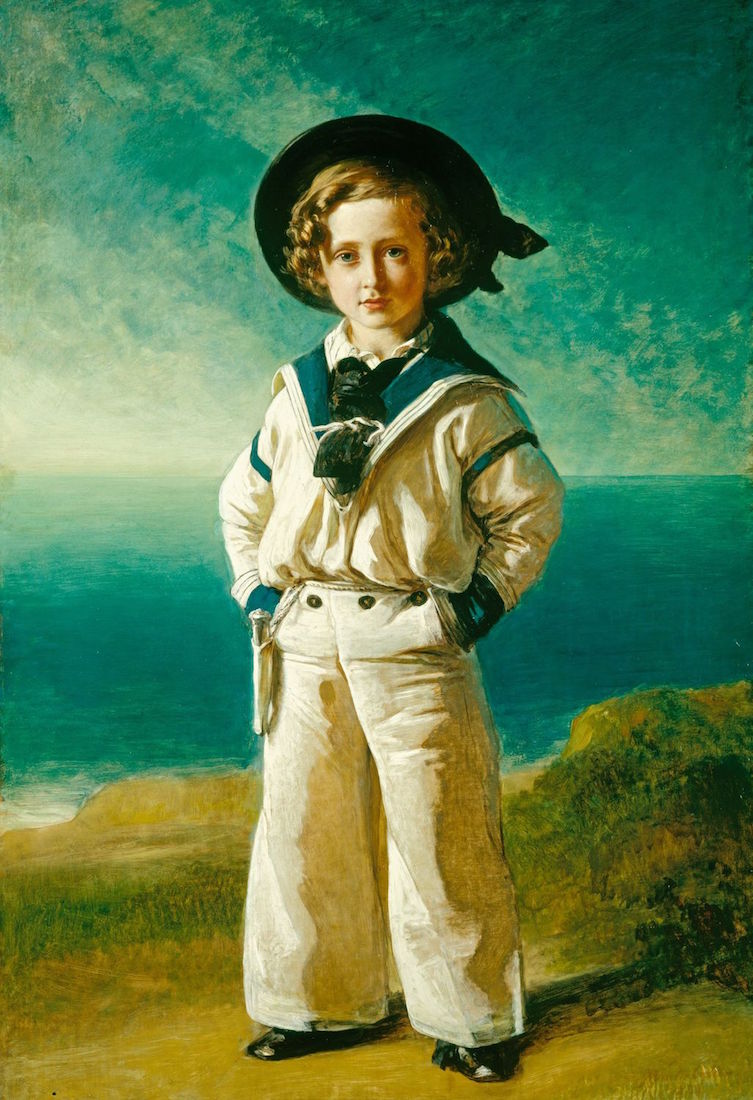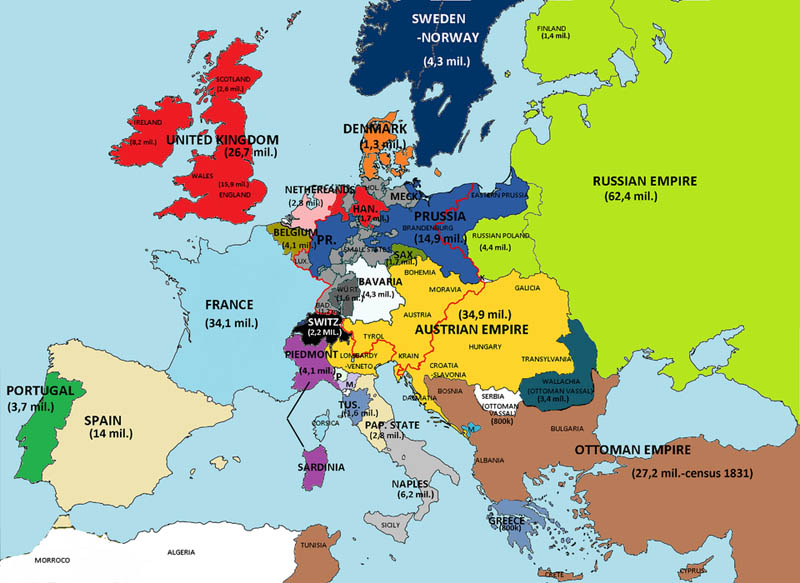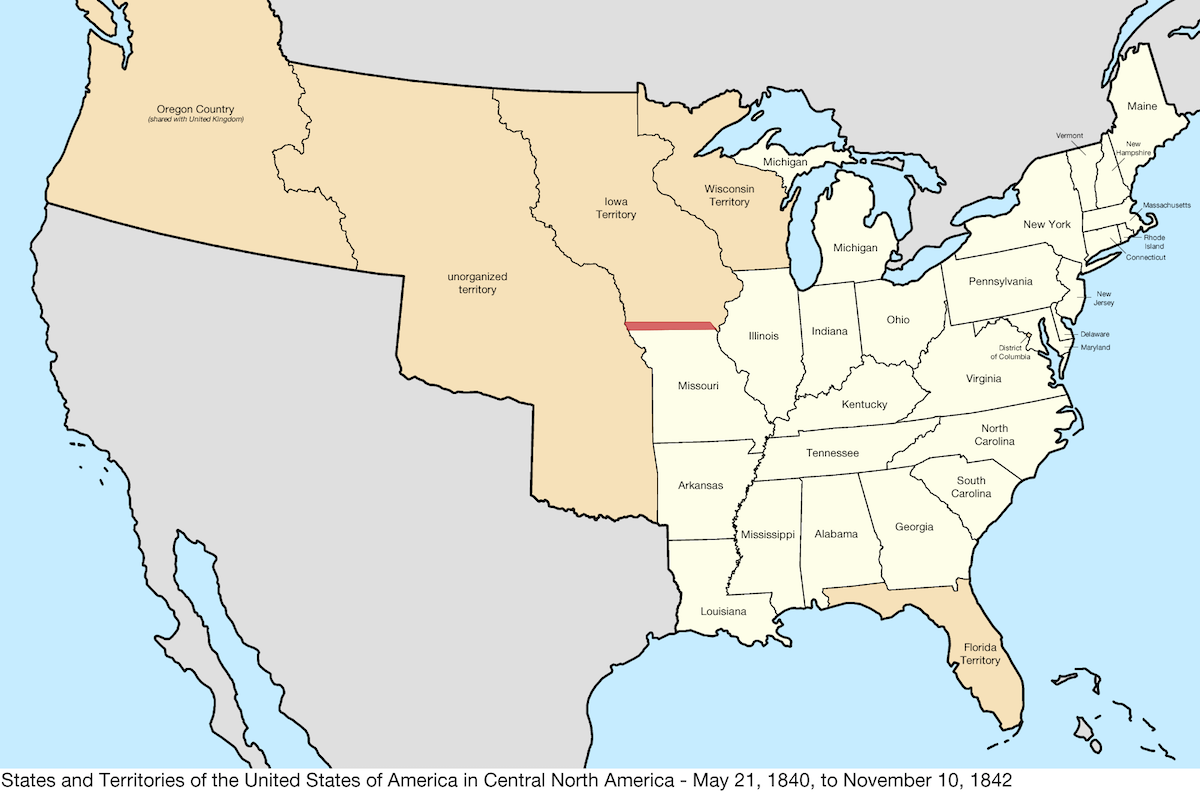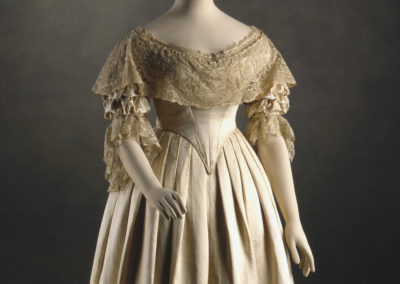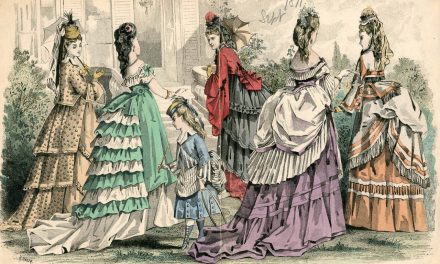OVERVIEW
Influenced by the Gothic Revival and Romanticism, the fashionable 1840s woman was demure, constrained by an unforgiving silhouette. Menswear was understated, as the bourgeois Victorian male became the fashion leader.
Womenswear
Restraint and restriction characterized the demure style of women’s fashions in the 1840s (Fig. 1). Fashion historian Jane Ashelford notes:
“Fashion illustrators no longer depicted the fashionable lady as a spirited and animated being, but rather as a timid, reticent and self-effacing person sheltering behind the ever-encroaching brim of her bonnet.” (193)
The 1840s were the last years of the Romantic Era (Tortora 328), but the exuberant buoyancy of the Romanticism that marked womenswear in the 1820s and 1830s had developed into a drooping, subdued style more associated with the Gothic Revival (Byrde 45). Romanticism was reflected throughout culture during the first half of the nineteenth century, defined by an emphasis on emotion, the individual, and what was believed to be the moral perfection of nature (Bassett 16). Literature portrayed sentimental, subservient female heroines who died for love or women who were cold and cruel, causing heartbreak to those who loved them (Tortora 330).
Fig. 1 - Héloïse Leloir and Louis Berlier (French, Leloir: 1819-1873). La Mode, April 1848. New York: The Metropolitan Museum of Art, b17509853. Gift of Mary P. Hayden. Source: The Met Digital Collections
Early Victorian ideals of meek, delicate women were fully established during this period; the ideal woman was quiet, modest, and the center of domestic life. A pale complexion was the most fashionable, and it was considered almost vulgar to appear too healthy (Laver 170). Female moral virtue was displayed through fashions that while covering more skin than in the past few decades, also took on a rigid, almost Puritanical restraint. Women’s clothes became so constricting that her passivity in society was clear (C.W. Cunnington 135).
Another tenet of Romanticism was historicism, and 1840s fashions reflected the period’s tendency to look backward for inspiration. For example, the long, inflexible bodice recalled those of the sixteenth and seventeenth centuries. Perhaps the clearest influence on womenswear was the Gothic Revival, a movement that imitated the architecture of the medieval period, and was closely tied to the historicism of the Romantics. Women became walking Gothic structures as their dresses were dominated by narrow arches and angles (Bassett 31, 49; Shrimpton 8).
Even the average woman of limited means was aware of fashionable trends due to the booming ladies’ magazine industry. In America, Godey’s Lady’s Book and Peterson’s Magazine reigned supreme, but French and English magazines could be found as well. The fashion plates published in these periodicals allowed all women to consume proposed fashions (Tortora 330-331; Severa 2-3).
During the 1840s, women’s clothing was all hand-sewn, and had to be custom-made either at home or by a hired seamstress. While Elias Howe invented the lock-stitch sewing machine in 1846, it would not come into widespread use until the following decade. In general, all women had a sound understanding of sewing, and many items were made at home. However, as paper patterns were not yet widely available, and the complexity of 1840s dresses were difficult to achieve for an amateur, it was recommended that any woman who could afford to hire a professional seamstress do so (Byrde 131, 137). Decent seamstresses could be found in villages and cities everywhere (Severa 8). Very few items of women’s dress were available readymade other than corsets and loose-fitting cloaks and mantles (Tortora 330).
Fig. 2 - Designer unknown (American or European). Corset, 1840s. Cotton. New York: The Metropolitan Museum of Art, C.I.42.74.12. Gift of Miss Genevieve Karr Hamlin, 1942. Source: The Metropolitan Museum of Art
Fig. 3 - Designer unknown (American). Dress, ca. 1843. Wool, silk. New York: The Metropolitan Museum of Art, 2009.300.43. Gift of the Brooklyn Museum, 2009. Source: The Metropolitan Museum of Art
The silhouette of the 1840s consisted of a long-waisted bodice, tight, narrow sleeves, and a full, dome-shaped skirt that now skimmed the floor. By the very beginning of the decade, the high waist of the 1830s had lengthened into a long, severely constricted torso marked by a bosom that was flattened and spread outward (Severa 8). This unnatural shape was achieved by a corset that ran from the breasts down over the hips, enforced with multiple channels of heavy cording and whalebone. Most importantly, all corsets featured a channel in the center front, into which would be placed a long, flat busk made of steel, wood, or whalebone (Fig. 2). This rigid busk would run from between the breasts all the way down over the belly, preventing a woman from bending at the waist. Corsets laced up the back in this period (P. Cunnington 148-149).
The bodice was carefully tailored to fit smoothly and closely over the waist, usually ending in a sharp point; this point softened to a rounded curve at the end of the decade (Severa 75). Overall, bodices of the 1840s featured a V-shape effect that emphasized the long, small waist and sloped shoulders. Boning at the seams supported the tailored shape, further restricting a woman’s movement (Shrimpton 8). Throughout the decade, the bodice often featured front fullness over the bosom that was carefully worked into the narrow waist in a variety of ways (Byrde 48). A common style was a fan-pleated bodice with soft pleats over the chest carefully drawn into a sharp point, often ending in a shirred panel (Fig. 3) (Fukai 180-181; Tortora 335-336). Usually seen on more formal dresses, another style was a puffed section of intricate, deep pleats across the bosom, which gave a “pouter-pigeon” effect to the gown (Fig. 4). In the late 1840s, it was more usual to see a plain, finely tailored bodice with long darts (Fig. 5) (Severa 9, 43).
In the first years of the 1840s, sleeve and bodice styles of the late 1830s were still seen (Fig. 6) (C.W. Cunnington 135-137; Severa 29). But by about 1842, the dominant sleeve style, by far, was a narrow, tightly-fitted one; these sleeves were usually cut on the bias, resulting in a swirling effect if made with a print (Thieme 27). Sleeves were set in below the shoulder with such a closely-fitted armscye that it was often impossible for a woman to lift her arms above 90 degrees. Sleeve caps at the top of the arm, sometimes trimmed with fringe or ribbon, were common sleeve decorations (Fig. 7) (Severa 7-9). Late in the decade, sleeves began to loosen; sometimes they opened into a narrow bell shape, an early version of the pagoda sleeve that would dominate the 1850s (Fig. 5). Sometimes the lower section was slit to reveal a fine white undersleeve; these slits could be held together with passementerie trims such as braid and cord (Johnston 68; Thieme 35).
Fig. 4 - After Franz-Xaver Winterhalter (French). Louise d'Orléans, Queen of the Belgians (1812-1850), 1844-1845. Oil on canvas; 220.5 x 143 cm. Versailles: Chateau de Versailles, MV 5110. Source: Wikimedia
Fig. 5 - Photographer unknown (American). Clark Sisters - grandmother and aunts of photographer Frances Benjamin Johnston, Late 1840s. Daguerrotype. Washington: Library of Congress, DAG no. 1122. Gift; Frances Benjamin Johnston. Source: Costume Cocktail
The skirt of the 1840s was ever-widening and the hemline touched the ground. It became common to sew a “hem saver”, a stiff band of wool or horsehair, to the inside of skirts to protect them from wear (Severa 8). By 1841, a new technique called gauging (or the more modern terms “organ pleating” or “cartridge pleating”) became typical; the full straight width of fabric was carefully pleated to the bodice in a series of careful, tiny pleats (Fig. 7). These new stitches created a distinctive dome shape by abruptly, but gracefully, throwing out the volume from the waist. The many, tiny pleats also accentuated the long, sharp point of the bodice (C.W. Cunnington 132, 138; Foster 13; Johnston 52).
The desirable size of the skirt grew throughout the decade, requiring more and more petticoats to support the fashionable width. At least two petticoats were required for standard day wear, and by the end of the decade, a woman may have worn as many as six or seven (Bruna 178; Severa 17). At least one of these petticoats would be a crinoline, or one made with a horsehair warp and wool weft to provide extra stiffness (P. Cunnington 145). At the beginning of the decade, a small bustle was still sometimes worn to support the top of the skirt at the back, but this was abandoned as the decade wore on (Thieme 35; Byrde 50).
In the daytime, necklines varied during the 1840s. A deep-V shape was common throughout the decade. During the early 1840s, a wide, shallow neckline that was nearly off-the-shoulder could be seen on dressier day gowns for younger women (Fig. 6) (C.W. Cunnington 135). By the end of the decade, day dresses usually featured a high, rounded neckline. White collars were universally worn and varied in size through the decade. Often, frilled white removable cuffs, called manchettes, were worn at the wrist (Severa 12, 36). In the evening, necklines dropped off the shoulder and could be either straight or en coeur, dipped in the center (Fig. 4). Frequently evening gowns were trimmed with a bertha, a wide straight panel of fabric hanging from the neckline (Fig. 8); usually made of lace, they also recalled the collars of the 1660s, a reflection of the era’s historicism (Byrde 51). The bertha usually covered the narrow sleeves that became short in the evening (Tortora 336).
The 1840s are marked by a general lack of trim; dresses of this period were usually rather plain. Instead, the focus of fashion was on the textiles. Fine silk was becoming accepted for daywear, especially “shot” silks in which the warp and weft are of different colors producing a subtle change of hue depending on the light (Fig. 9) (Shrimpton 9; Thieme 35). The crispness of silk was ideal for shaping the long, narrow bodice and voluminous skirt, and the subdued beauty of shot silks were considered especially appropriate (Johnston 52; Foster 13). Eighteenth-century silks were very fashionable, another aspect of the 1840s historical inspiration. Original textiles were salvaged from antique dresses and re-made in the 1840s silhouette (Fig. 10) (Byrde 51). Frequently the only trim on a dress was matching piping on the seams; this self-fabric trim maintained the focus of the ensemble on the textile (Johnston 196). Cotton, wool, and linen were also worn, usually for standard morning attire and less dressy occasions. Patterned designs were also seen, often florals, stripes, and plaids in understated colors.
Fig. 6 - Franklin R. Street (American, 1815/16–before 1894). Portrait of Elizabeth Brown Montier, 1841. Oil on canvas; (32 x 26 in). Philadelphia: The Collection of Mr. and Mrs. William Pickens, III on loan to the Philadelphia Museum of Art. Source: The Philadelphia Museum of Art
Fig. 7 - Designer unknown (American). Afternoon dress, detail, ca. 1845. Silk, cotton. New York: The Metropolitan Museum of Art, 2009.300.928. Gift of the Brooklyn Museum, 2009. Source: The Metropolitan Museum of Art
Fig. 8 - Marcel Verdier (French, 1817-1856). Mary Matthews, Madame Julien-Francois-Bertrand de La Chere (1824-1890), 1843. Oil on canvas; 115 x 88 cm. Cumbria, England: National Trust, Sizergh Castle and Garden, 998472. Gift from Henry Hornyold-Strickland, 1950. Source: Wikimedia
Fig. 9 - Designer unknown (American). Afternoon dress, ca. 1845. Silk, cotton. New York: The Metropolitan Museum of Art, 2009.300.933a,b. Gift of the Brooklyn Museum, 2009. Source: The Metropolitan Museum of Art
Fig. 10 - Designer unknown (English). Evening dress, ca. 1840. 18th century spitalfields silk. New York: The Museum at FIT, P87.20.7. Museum Purchase. Source: The Museum at FIT
Fig. 11 - Designer unknown (American). Day dress and Pelerine, 1843-45. Silk. Cincinnati, OH: The Cincinnati Art Museum, 1990.51a-f. Gift of the Lee, Bryant and Paine Costume Collection in memory of Georgina Paine Fisher Howland. Source: The Cincinnati Art Museum
It was considered uncouth and unladylike to be seen in public without some covering over one’s dress during this period. Pelerines, usually made to match the dress, were common lightweight outerwear (Fig. 11); these were cape-like coverings that featured long lappet ends in the front (Thieme 31-35; Cumming 153). Various styles of mantles and coats were fashionable; pardessus was a generic term that referred to any number of outerwear styles (Shrimpton 10; Tortora 338). Shawls were popular as well, particularly cashmere shawls (Fig. 12), frequently imitations from mills in Europe, as opposed to the extremely expensive imports from India (Laver 175). The grace with which a woman wore her shawl was a practiced art that reflected the wearer’s taste and manners (Severa 14-15).
Women wore their hair parted in the center, and looped smoothly over the ears, drawn back into a chignon or bun. An alternate style, worn especially by younger women for dressier occasions, consisted of long ringlet curls hanging on either side of the face, with the rest of the hair drawn back into a chignon (Foster 13; Severa 43). Women often wore white cotton or linen day caps indoors, placed at the back of the head, that could feature hanging lappets of lace (Tortora 338). The bonnet was the universal choice for outdoor millinery. During the 1840s, it became closely-fit, and the crown became indiscernible from the brim which curved down around the face (Fig. 13). The brim came forward so far that it greatly limited a woman’s periperal vision, and made it difficult to see her face, except from directly in front of her (Foster 13; Severa 10-11). Fashion historian C.W. Cunnington noted that:
“The bonnet supplied more than a material protection; it supplied a moral check…it was not until the close of the decade that the fair wearer could obtain a glimpse of aught but the straight and narrow path ahead.” (156)
Fig. 12 - David Octavius Hill and Robert Adamson (Scottish, Hill: 1802-1870, Adamson: 1821-1848). Elizabeth (née Rigby), Lady Eastlake, 1843-48. Calotype; (8 1/8 x 6 1/8 in). London: National Portrait Gallery, NPG P6(124). Given by an anonymous donor, 1973. Source: National Portrait Gallery
Fig. 13 - Designer unknown (American). Bonnet, ca. 1840. Leghorn straw, ribbon, ombré. Boston: Museum of Fine Arts Boston, 51.658. Gift of Miss Marjorie W. Childs. Source: Museum of Fine Arts Boston
Fashion icon: Jenny Lind (1820-1887)
Fig. 1 - Eduard Magnus (German, 1799-1872). Jenny Lind, ca. 1861, replica of a work of 1846. Oil on canvas; (46.5 x 37.25 in). London: National Portrait Gallery, NPG 3801. Bequeathed by the sitter's son, Ernest Svend David Goldschmidt, 1951. Source: National Portrait Gallery
Fig. 2 - Frederick de Bourg Richards (American, 1822-1903). Jenny Lind, ca. 1850. Photograph; 15.1 x 12.6 cm. Washington, D.C.: Library of Congress, LOT 14120, no. 22 [P&P]. Source: Library of Congress
During the 1840s and early 1850s, there was scarcely a more famous performer than Jenny Lind. A true celebrity, Lind was one of the first personalities whose name was used to sell clothing and accessories. Born in Stockholm, Sweden in 1820, Lind was one of the most critically acclaimed opera singers of the nineteenth century. She delighted audiences all over Europe and the United States, her stunning voice earning her the moniker, “The Swedish Nightingale.” After starring in her first opera in Stockholm in 1838, Lind spent the next decade touring cities throughout Europe. It was reported in 1847, when she made her debut in London, that the city “went mad about the Swedish nightingale” (Brittanica). She was catapulted to a new level of fame, when she began a tour of the United States in 1850, under the management of American showman, P.T. Barnum. Before her arrival, Barnum, an expert promoter, created publicity through a series of advertisements and events to auction tickets; by the time she arrived “Lindomania” was gripping the nation (Shrumm). Crowds packed the streets of New York to greet Lind as she steamed into the harbor, and she went on to perform 93 concerts to adoring, sold-out audiences (Spongberg ch. 14-18).
Jenny Lind did not wear elaborate or flashy fashions as one might assume for such a sparkling celebrity; for her American tour, she performed in an understated white gown. In portraits, she is usually depicted in elegant, if simple and modest, fashions (Fig. 1). However, in a decade defined by demure restraint, this was precisely her appeal (Shrumm). Her clothing choices were only an element of the larger refined morality about her persona. Biographer Ernest Albert Spongberg noted,
“There was an air of virginal simplicity and modesty in every movement which set her apart from her stage sisters… for moving in the midst of a world which had watched her every action, not the faintest breadth of scandal ever shaded [her] fair name.” (ch. 4)
She was someone that both affluent and middle-class women could aspire to emulate, and that was reflected in the mania for clothing items named for the famous singer. For example, in the late 1840s, a trend emerged for the “Jenny Lind” collar, a modest, straight collar featuring edging, inserting, or a small ruffle (Fig. 2) (Severa 12). After she performed in any city, particularly on her American tour, shops would sell items inspired by Lind. Spongberg noted that as she moved through the States,
“There were Jenny Lind gloves, Jenny Lind bonnets, Jenny Lind riding hats, Jenny Lind shawls, mantillas, ropes, chairs, sofas, pianos-in fact everything was Jenny Lind.” (ch. 14)
Milliners and dressmakers could greatly benefit from her patronage as well, which was a 19th-century celebrity endorsement (Spongberg ch. 14); reportedly Mrs. R. B. Dickinson, a milliner in Northampton, Massachusetts, enjoyed a boom in her business after Lind visited her shop in 1851 (Severa 49). A fashionable role model, Jenny Lind’s name enjoyed an outsized presence in the dress of the 1840s and early 1850s.
menswear
Menswear of the 1840s became less exaggerated than the previous decade, and grew increasingly understated and somber (Fig. 1). Fashion historian James Laver writes,
“The dominant figure was now a respectable bourgeois, who had no desire to make himself conspicuous but wished merely to present a gentlemanly appearance… what we are watching, in fact, in this period is the fading away of flamboyance and color from men’s garments.” (169-170)
The exaggerated hourglass silhouette of 1830s menswear, achieved with padding and closely shaped coats, gave way to a long, narrow line in the 1840s. The male waistline dropped, as in womenswear, for a long, fitted look (Shrimpton 30). Sleeves were narrow and no longer gathered into the armscye, which had created a puffed shoulder, but fit smoothly into a sloping shoulder line (Tortora 342). Unlike womenswear, clothing for men was widely available readymade by this period (Severa 2, 19; Byrde 144).
In the 1840s, the frock coat became standard daywear; it was a coat with a horizontal waistline seam and full skirts ending above the knee (Fig. 2). The frock was usually tailored in black or dark wool (Shrimpton 30). The tailcoat, which consisted of a squared front that cut at the waistline into long tails at the back, could still be seen for formal day occasions (Fig. 3). However, tailcoats were increasingly relegated to evening wear. For more informal occasions, the “newmarket” or riding coat, a relatively new style, could be worn; it was a type of tailcoat that featured a gradual slope to the tails that began above the waist (Tortora 342; Cumming 140). The gentlemen on the right and left of Figure 4 wear newmarkets. This coat would develop into the morning coat of later decades (Waugh 113). A new type of jacket began to be seen in the 1840s for leisurely occasions: the lounge or sack jacket. Sacks were cut straight, without a waistline seam, and despite the relaxed name still featured high, tight sleeves and a narrow overall fit, as other coats did (Severa 19).
Trousers were narrowly fitted. This long, smooth line was maintained by a strap that passed under the foot, although the instep strap gradually disappeared through the decade. Usually, trousers did not match the coat but were made in lighter colors or even tweeds and plaids (Laver 168-169; Tortora 342). However, it was possible to purchase a suit with matching jacket and trousers; sack jackets were available with matching vests and trousers in a suit advertised as “dittoes” (Severa 20).
Fig. 1 - Eden Upton Eddis (British, 1812-1901). Edward Gordon Douglas-Pennant (1800–1886), 1st Lord Penrhyn of Llandega, 1842. Oil on canvas; 261.5 x 145 cm. Bangor, Wales: National Trust, Penrhyn Castle, 1421758. Accepted by HM Treasury from Lady Janet Pelham and John Charles Harper, and allocated to the National Trust, 1951. Source: Art UK
Fig. 2 - Designer unknown (British). Frock Coat, ca. 1840. Wool, cotton. Edinburgh: National Museum Of Scotland, H.TI 5. Source: National Museum Of Scotland
Fig. 3 - Designer unknown (English). Man's Ensemble (Tailcoat, Vest, Trousers, Neck Cloth), 1840s. Tailcoat: wool twill, fulled (broadcloth), with metal buttons. vest: cotton plain weave, printed. Los Angeles: Los Angeles County Museum of Art, M.59.24.2a-f. Costume Council Fund. Source: Los Angeles County Museum of Art
Fig. 4 - Artist unknown (Spanish). O Corrieo das Damas: Fashion Plate, April 25, 1843. New York: The Metropolitan Museum of Art, b17509853. Gift of Woodman Thompson. Source: The Met Digital Collections
Fig. 5 - Designer unknown (English). Man's Vest, ca. 1840. Silk cut and voided velvet. Los Angeles: Los Angles County Museum of Art, M.2007.211.818. Purchased with funds provided by Suzanne A. Saperstein and Michael and Ellen Michelson. Source: Los Angeles County Museum of Art
Fig. 6 - Parsons & Co. Littlefield (American, 1858-1866). Daguerrotype of a man in a paisley vest, Photo: Late 1840s, Case: 1860s. Photographic plate with velvet case; 9.5 x 16.5 cm. Washington, D.C.: National Museum of African American History & Culture, 2008.9.15. Collection of the Smithsonian National Museum of African American History and Culture. Source: NMAAHC
By 1840, all trousers were made with a center fly front, as opposed to the earlier fall-front design (Waugh 116). Knee breeches and the tightly-fitted pantaloons were only worn for country sportswear or ceremonial dress by this period (Tortora 342). By far, the most visually exciting, decorative element of menswear was the waistcoat or vest (Figs. 5-6). Vests usually featured a deep-V and were made in a variety of rich and colorful patterned silks (Johnston 198; Shrimpton 31). Shirts were almost always white and worn with starched, turned-up collars. The dominant neckwear was a dark silk tie or cravat tied into a flat bow; a common variety was a stock, consisting of a silk tie arranged on a wire or buckram frame that easily hooked in the back (Fig. 7) (Severa 21, 63; Waugh 118).
The top hat, typically of glossy silk with a crown of seven to eight inches tall, was de rigueur (Shrimpton 31). In the country with sporting tweeds, a wide-brimmed felt hat called a wide-awake could be worn (Ginsburg 87). Regarding outerwear, the greatcoat, usually a double-breasted long, skirted coat, was still seen; a variation was the curricle coat or carrick coat which featured capes at the shoulder. The shortened and loose paletot, often lacking a waist seam, was another option (Tortora 343; Waugh 114-115). Men wore their hair ear-length, parted to one side, and were usually clean-shaven, although towards the end of the decade some men began to sport facial hair (Figs. 4,6) (Severa 23).
Fig. 7 - David Octavius Hill and Robert Adamson (Scottish, Hill: 1802-1870, Adamson: 1821-1848). John Murray, 1840s. Calotype; (8 3/4 x 6 in). London: National Portrait Gallery, NPG x26046. Given by Scottish National Portrait Gallery: Edinburgh: UK, 1970. Source: National Portrait Gallery
CHILDREN’S WEAR
As throughout the nineteenth century, infants of the 1840s wore long, short-sleeved dresses; these were usually white so they could be easily laundered (Paoletti 87). These dresses, while plain in shape with a short bodice and narrow sleeves, could be decorated with fine embroidery called Ayrshire work and lace, especially for christening gowns (Buck 47; Shrimpton 43). When babies reached about nine months old, they were put into shorter frocks that allowed them to begin to move, along with short cotton drawers. Both boys and girls wore these shortened dresses until about the age of four or five. These dresses often featured set-in waistbands and full skirts (Fig. 1), and the short cap sleeve was most common (Severa 23). Toddler dresses sometimes had matching capes (Rose 63).
Girls were dressed as miniature adults, with the length of their dresses often the only distinguishing feature. By five years old, a girl’s hemline was just below her knee and by twelve, it reached mid-calf. During this phase, she wore long white cotton pantalettes that peeked out from beneath the hem (Severa 24).
Fig. 1 - Designer unknown (American). Toddler's dress, 1845-50. Wool, cotton. New York: The Metropolitan Museum of Art, 2009.300.2985. Gift of the Brooklyn Museum, 2009. Source: The Metropolitan Museum of Art
Fig. 2 - Artist unknown (French). Longchamps: Fashion Plate, February 20, 1841. New York: The Metropolitan Museum of Art, b17509853. Gift of Woodman Thompson. Source: The Met Digital Collections
Another distinguishing feature from adult dresses was the neckline; women’s day dresses featured high necklines but younger girls’ dresses could be off-the-shoulder (Fig. 2). Besides length and necklines, girls’ dresses reflected their mothers’. The bodices became long-waisted and pointed, sleeves were tight, and the full skirt was carefully pleated to the bodice, similar to the adult silhouette (Fig. 3). Girls’ bodices could feature boning, and girls began corset training as young as ten years old, wearing lightly boned cotton corsets. Like adult women, young girls wore multiple petticoats, at least two at a time (Buck 230, 241). Girls could be seen in wide-brimmed, shallow-crowned hats tied with wide ribbons, a definite childhood style (Fig. 4) (Severa 24), but it was common for even young girls to wear bonnets that hid the face, much in the adult style (Buck 139). Between the ages of fourteen and sixteen, a girl’s hem would drop to the floor, and her hair would be pulled back into adult styles, completing the transition to a young woman (Fig. 5).
Fig. 3 - Designer unknown (American). Girl's dress, 1840-44. Toronto: Royal Ontario Museum. Source: Wikimedia
Fig. 4 - Hermann Winterhalter (German, 1808-1891). Princess Charlotte of Belgium (1840-1927), 1848. Oil on canvas; 99.0 x 66.8 cm. East Cowes, England: Royal Collection Trust: Osbourne House, RCIN 403674. Source: Royal Collection Trust
Fig. 5 - Photographer unknown (American). Mary Frances Stebbins at Age 14, 1843-45. Daguerreotype. Northampton, MA: Historic Northampton, 59.408. Source: Historic Northampton Online Digital Catalog
Boys were breeched, or given their first pair of trousers, at about age five (Tortora 345). They then entered a transitional phase until about age ten, still too young for adult-like coats and trousers but too old for the dresses of toddlerhood (Rose 93). Young boys wore skirted tunics, either cut loose and belted at the waist or fitted with a set-in waistband, over wide, ankle-length trousers (Fig. 6). Very young boys, between about five and seven, might still wear frilled cambric drawers underneath such tunics (Cunnington and Buck 179). Bright color combinations, strong trims such as black braid, and metal buttons maintained a masculinity about these tunics (Rose 95). The young Prince of Wales, Prince Albert Edward, sometimes wore a sailor suit when he was this age, introducing the style (Fig. 7). Consisting of loose trousers and a loose top with a middy collar, the sailor suit became a wildly popular choice for young boys in the second half of the nineteenth century (Buck 122).
Around age ten, a boy graduated to trousers and jackets. The dominant jacket type for boys at this age was the roundabout, a tightly-fitted jacket that ended at at the waist; observe the boy at the left of figure 8. It was worn with a white shirt with a turned-down collar, and trousers, often of white linen. Another type of jacket, especially as boys reached teenage years, was the lounge or sack, available in ditto suits. Very young boys wore wide-brimmed straw hats not unlike those worn by young girls, and as they got older they wore peaked caps, often trimmed with a tassel hanging to one side (Severa 24, 67; Buck 220, 226). At about fourteen or so, a boy would change the youthful round jacket for a frock coat and a top hat, a final sign of growing into an adult (Fig. 8) (Buck 221).
Fig. 6 - Artist unknown (American). Boy in Plaid, ca. 1845. Oil on canvas; (30 7/8 x 25 1/2 in). Williamsburg, VA: Colonial Williamsburg, 1936.100.14. Gift of Abby Aldrich Rockefeller. Source: Colonial Willamsburg
Fig. 7 - Franz Xaver Winterhalter (German, 1805-1873). King Edward VII (1841-1910), when Albert Edward, Prince of Wales, 1846. Oil on canvas; 127.1 x 88.0 cm. London: Royal Collection Trust, RCIN 404873. Source: Royal Collection Trust
Fig. 8 - Artist unknown (French). Longchamps: Menswear and Boy's Fashion Plate, April 20, 1841. New York: The Metropolitan Museum of Art, b17509853. Gift of Woodman Thompson. Source: The Met Digital Collections
References
- Ashelford, Jane. The Art of Dress: Clothes and Society, 1500-1914. London: National Trust, 1996. http://www.worldcat.org/oclc/243850605
- Bassett, Lynne Z. Gothic to Goth: Romantic Era Fashion and Its Legacy. Hartford: Connecticut Wadsworth Antheneum Museum of Art, 2016. http://www.worldcat.org/oclc/953101887
- Bruna, Denis, ed. Fashioning the Body: An Intimate History of the Silhouette. New Haven: Yale University Press, 2015. http://www.worldcat.org/oclc/945435796
- Buck, Anne. Clothes and the Child: A Handbook of Children’s Dress in England, 1500-1900. New York: Holmes & Meier, 1996. http://www.worldcat.org/oclc/243852072
- Byrde, Penelope. Nineteenth Century Fashion. London: Batsford, 1992. http://www.worldcat.org/oclc/26300526
- Cumming, Valerie ed., The Dictionary of Fashion History. New York: Berg, 2010. http://www.worldcat.org/oclc/1003643284
- Cunnington, C. Willett. English Women’s Clothing in the Nineteenth Century: A Comprehensive Guide with 1,117 Illustrations. Mineola, NY: Dover Publications, 1990. http://www.worldcat.org/oclc/868281120
- Cunnington, Phillis. The History of Underclothes. London: Michael Joseph, 1951. http://www.worldcat.org/oclc/759766118
- Cunnington, Phillis and Anne Buck. Children’s Costume in England: From the Fourteenth to the End of the Nineteenth Century. London: Adam & Charles Black, 1978. http://www.worldcat.org/oclc/174334043
- Foster, Vanda. A Visual History of Costume: The Nineteenth Century. London: BT Batsford, 1984. http://www.worldcat.org/oclc/28405843
- Fukai, Akiko, ed. The Collection of the Kyoto Costume Institute: Fashion, A History from the 18th Century to the 20th Century. Kyoto: Taschen, 2013. http://www.worldcat.org/oclc/81452017
- Ginsburg, Madeliene. The Hat: Trends and Traditions. London: Studio Editions, 1990. http://www.worldcat.org/oclc/22914760
- “Jenny Lind.” Britannica Online. Last updated October 29, 2019. https://www.britannica.com/biography/Jenny-Lind
- Johnston, Lucy, Marion Kite, Helen Persson, Richard Davis, and Leonie Davis. Nineteenth Century Fashion in Detail. London: V&A Publications, 2005. http://www.worldcat.org/oclc/61302743
- Laver, James. Costume and Fashion: A Concise History, 5th ed. London: Thames & Hudson, Ltd, 2012. http://www.worldcat.org/oclc/966352776
- Paoletti, Jo B. Pink and Blue: Telling the Boys from the Girls in America. Bloomington, IN: Indiana University Press, 2012. http://www.worldcat.org/oclc/809762103
- Rose, Clare. Children’s Clothes: 1750-1985. London: BT Batsford, 1989. http://www.worldcat.org/oclc/317672212
- Severa, Joan L. Dressed for the Photographer: Ordinary Americans and Fashion 1840-1900. Kent, OH: Kent State UP, 1995. http://www.worldcat.org/oclc/552147475
- Shrimpton, Jayne. Victorian Fashion. Oxford: Shire Publications, 2016. http://www.worldcat.org/oclc/896980798
- Shrumm, Regan. “Meet Jenny Lind, one of America’s first female celebrities.” National Museum of American History. Last updated March 16, 2016. https://americanhistory.si.edu/blog/jenny-lind
- Spongberg, Ernest Albert. The Life of Jenny Lind. Minneapolis, MN, 1920. http://www.worldcat.org/oclc/679862605
- Thieme, Otto C., Elizabeth A. Coleman, Michelle Oberly, and Patricia Cunningham. With Grace and Favor: Victorian & Edwardian Fashion in America. Cincinatti: Cincinatti Art Museum, 1993. http://www.worldcat.org/oclc/260147672
- Tortora, Phyllis G. and Keith Eubank. Survey of Historic Costume, 5th ed. New York: Fairchild Books, 2010. http://www.worldcat.org/oclc/865480300
- Waugh, Norah. The Cut of Men’s Clothes: 1600-1900. New York and London: Routledge, Taylor and Francis Group, 2015. http://www.worldcat.org/oclc/927414537
Historical Context
Wikipedia: 1840-1849
Rulers:
- England: Queen Victoria (1837-1901)
- France:
- King Louis Philippe I (1830-1848)
- Revolutions of 1848 (1848-1849)
- Second Republic:
- President Louis-Napoléon Bonaparte (1848-1852)
- Spain: Queen Isabella II (1833-1868)
- United States:
- Martin Van Buren (1837-1841)
- William Henry Harrison (1841)
- John Tyler (1841-1845)
- James K. Polk (1845-1849)
- Zachary Taylor (1849-1850)
Events:
- 1844 – The first electronic telegraph, invented by Samuel Morse, is sent from Baltimore to Washington, D.C.
- 1845 – Frederick Douglass’ memoir, Narrative of the Life of Frederick Douglass, An American Slave is published.
- 1845 – With the arrival of the railroad in the 1840s comes mass travel and clothes designed for travel, leisure, and vacations.
- 1845-1849 – The Great Famine ravages Ireland.
- 1845 – President James Polk invokes Manifest Destiny in his argument for aggressive expansion into the West.
- 1846 – Elias Howe patents his lock-stitch sewing machine.
- 1846-1848 – The Mexican-American War.
- 1848 – Known as the “Year of Revolutions” because of the series of political upheavals that take place throughout Europe.
- 1848 – The California Gold Rush begins.
- 1848 – Karl Marx and Freidrich Engels publish The Communist Manifesto.
- 1848 – The Women’s Rights Convention at Seneca Falls is held.
Timeline Entries
Primary/Period Sources
Resources for Fashion History Research
To discover primary/period sources, explore the categories below.
Have a primary source to suggest? Or a newly digitized periodical/book to announce? Contact us!
Fashion Plate Collections (Digitized)
- Costume Institute Fashion Plate collection
- Casey Fashion Plates (LA Public Library) - search for the year that interests you
- New York Public Library:
NYC-Area Special Collections of Fashion Periodicals/Plates
- FIT Special Collections (to make an appointment, click here)
- Costume Institute/Watson Library @ the Met (register here)
- New York Public Library
- Brooklyn Museum Library (email for access)
Fashion Periodicals (Digitized)
Etiquette Books (Digitized)
Secondary Sources
Also see the 19th-century overview page for more research sources... or browse our Zotero library.

